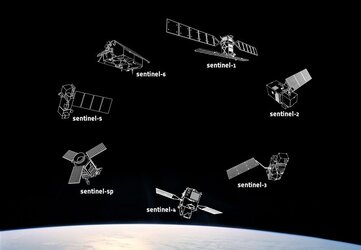Ramón Torres: Project Manager
Ramón Torres has been responsible for managing ESA’s Sentinel-1 project since 2010. In an interview, Ramón talks about his role as Project Manager along with some of the challenges and rewards he has experienced in getting this first Copernicus satellite built and ready for launch.

Ramón Torres, a Spanish national, joined ESA’s European Space Research and Technology Centre, ESTEC, in the Netherlands in 1989. Prior to joining the Sentinel-1 team in 2007 as the Payload Manager, Ramón worked as an Electromagnetics Engineer on a number of other projects, including Envisat. He participated in the conception of Sentinel-1 and, heading the project since 2010, he has seen the mission through critical stages of development and ensured its readiness for launch.
Ramón earned his Engineering degree in Telecommunications and Electromagnetics from the Technical University of Madrid in Spain and his Master’s in Space Systems Engineering from Delft University of Technology in the Netherlands.
ESA: What does being the Sentinel-1 Project Manager involve?
Ramón Torres
It involves leading a team of more than 60 of Europe’s best technical companies to build the first satellite in the most ambitious Earth observation programme ever conceived. It involves responding with excellence to the striving number of applications of the Copernicus programme to pave the way for the other Sentinels and the success of the programme as a whole. And, it involves launching the first satellite that has resulted from the cooperation between the European Commission and the European Space Agency.
ESA: Sentinel-1 carries a large radar instrument, what sets it apart from radars on other satellites?
Ramón Torres
Well, it is very easy for me to say that theSynthetic Aperture Radar(SAR) on board Sentinel-1 is notably the best of its class. And, it is so because it has been defined and optimised for the demanding objectives of the Sentinel-1 mission. It combines and exploits the key technologies developed separately for the latest very successful national SAR missions in Germany (TerraSAR-X) and Italy (Cosmo-SkyMed), and benefits from all the lessons learned through the unique experience of ESA’s ERS-1, ERS-2 and Envisat, from 1991 to date.
ESA: Sentinel-1 is designed as a two-satellite constellation. Have both satellites been built is parallel?
Ramón Torres
The two Sentinel-1 satellites, Sentinel-1A and Sentinel-1B, are absolutely identical and have been built in sequence. The equipment and subsystem suppliers have been producing and delivering their second units while the first spacecraft was being integrated and tested. At present, with Sentinel-1A in the launch pad, all the Sentinel-1B equipment has been completed and delivered and is being integrated. Sentinel-1A has been used also to qualify the design and the processes, therefore, suffering a more ‘painful’ development with more tests and more aggressive profiles. Sentinel-1B is more fortunate, having a much easier life.
ESA: What have been the main challenges ensuring that Sentinel-1 will deliver exactly what Copernicus users need?
Ramón Torres
Precisely that: the materialisation of a mission to deliver exactly what the Copernicus users, present and future, will expect, and to make it quick and to make it simple. In addition to the quality of the data and products, Sentinel-1 is all about systematic, reliable and timely delivery of products to the users. The big challenge is still to come, Sentinel-1A is an almost perfect mapping machine, but it is only an element in the chain. My vision is that in few years, the Sentinel-1 products will be as expected, delivered and trusted as the weather forecast information is provided to the end users every day.
ESA: Could you explain the advantages of having the additional data link to the EDRS satellites?
Ramón Torres
In order to downlink to ground the large volume of data that Sentinel-1A will be constantly and routinely acquiring (up to 1.5TB per day), the mission requires the constant use of up to four ground stations, shared with other missions and, in particular, the other Sentinels. The availability of data to users depends on the combination of the geographical locations and the orbit opportunities of ground station visibility. Having the additional link to EDRS will provide the maximum data downlink capability since full visibility is guaranteed every orbit, and will contribute to achieving the goal of data delivery to users in as little as tens of minutes.
ESA: What have been the most rewarding aspects of working on Sentinel-1?
Ramón Torres
The whole process of producing the different equipment and subsystems, integrating them, and step-by-step giving form to the Sentinel-1A satellite has been very gratifying. The achieved quality of the final spacecraft is a very important reward, but this could not been achieved without the excellence, the dedication and the commitment of each and every individual that have contributed to it, from the system engineers to the machine operators, from the managers to the software engineers, through the successful stories to the most painful solution of anomalies. But, something that I personally consider most rewarding is the excellent collaboration that I have had the privilege to lead between the otherwise fierce competitors in the space business, Thales Alenia Space and Airbus Defence & Space. Their extraordinary commitment to the success of this mission, to the final launch sequence countdown, has been paramount for Sentinel-1.
Editor's note:
This is one in a series of interviews with a few of the key people that are involved in the Sentinel-1 mission. Please check back as the list will be added to over the coming weeks.






